PreSonus recently debuted their versatile Eris Pro 8 and Sub 10 monitors with a symmetric design. It’s positioned as a monitoring system for surround setups, but can also be used effectively as a compact system for project studios. We utilized four reviewers for this long-term review – their impressions in quotes below.
The Eris Pro 8 monitors are quite lightweight for an active Class AB amplified system, which makes easy to fly (hang from a ceiling or truss) or mount on a wall. They feature a 1.25″ silk dome tweeter and an 8″ woven-composite, low-frequency driver housed in a front ported cabinet made from Medium Density Fiberboard with a gray vinyl cover. It has a claimed frequency response of 35 Hz to 20 kHz and delivers140 Watts of juice (75W for the woofer and 65W for the tweeter). A horizontal blue LED light on the front of the speaker denotes when the speaker is active, and white when it sleeps in standby mode.
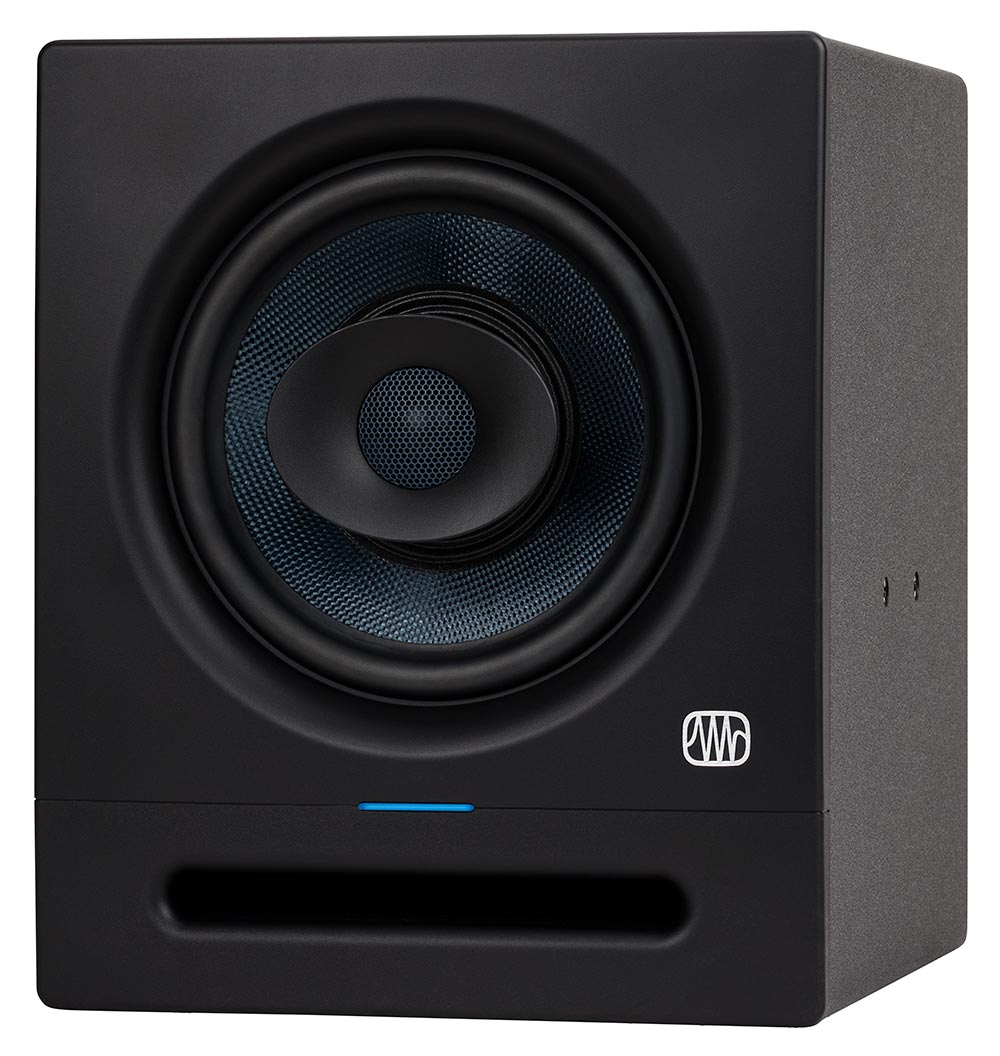

For a limited time only! Up to 80% off all Waves Bundles. PLUS click the banner above or the Go button for an additional 10%! This is Waves best deal yet! Get yours today before this special ends! Go!
On the back, you have three analog inputs, unbalanced RCA, balanced TRS 1.4″ and balanced XLR. A designated Gain control allows you to reduce or boost the signal. At this price point, you wouldn’t expect acoustic tuning controls, but the Eris Pro allows you to tailor the sound based on the unit’s placement in your room. In addition, the Eris Pro 8’s are protected from RF interference, output-current limiting and over-heating. They also feature a welcomed turn-on/off transient to prevent pops when powering on or off, and a subsonic filter to weed out ultra low frequencies.
To prevent pops when powering on or off, the Eris Pro 8’s feature a transient alleviation system
Initially, our reviewers where skeptical of the Eris Pro 8’s, “the vinyl veneer on the sub was already compromised due to a small knock when I received the monitor from a previous reviewer, revealing the plasterboard underneath.” Not only that, another evaluator was turned off by “the sloppy glue field where the tweeter meets the middle of the woofer.” These two observations uncover the challenges and compromises that companies have to address when manufacturing in Asia, as well as to hit certain price points. PreSonus most likely had to shave costs in the cabinet materials and the assembly, and invest those resources in better quality electrical components. It’s a fine balancing act, but our reviewers found that the Eris Pro 8’s sonic signature benefitted from the trade off.
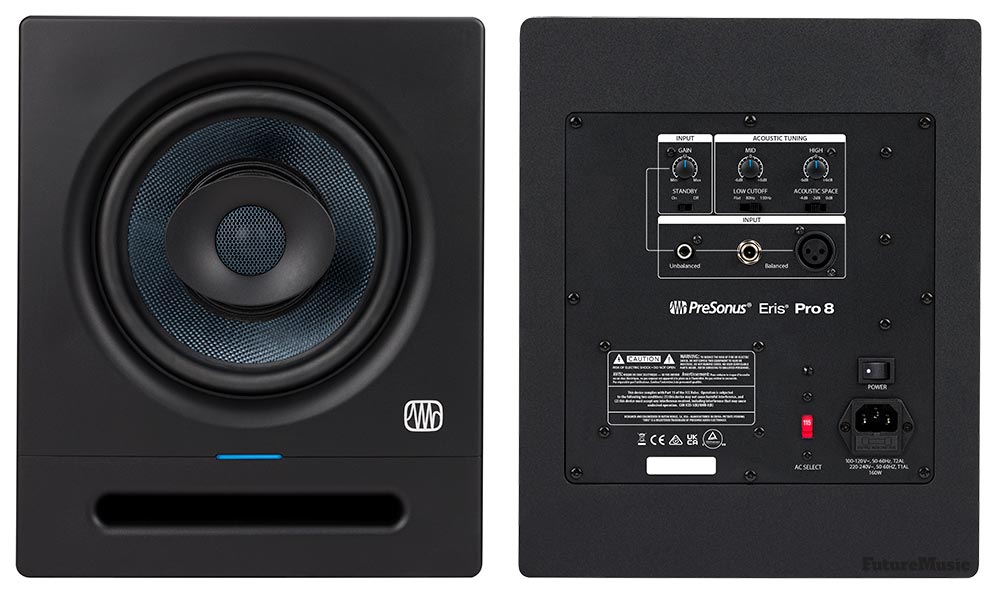
The front and back of the PreSonus Eris Pro 8 Monitors
All of our reviewers found the woofers provided a “nice punch,” but lacked “some depth and energy.” This “was healed by the addition of the Pro Sub 10” (see below), which alleviated this deficit by “providing a pregnant bottom” with “enough detail” to make mixing the low end “less of an ordeal with monitors of this size.” While the “high end was clean and vivid” the “midrange was too prominent” and “needed to be held back with the rear tuning controls.”
PreSonus included their Eris Pro Sub 10’s with the Pro 8’s and our testers found this to be a mandatory addition for electronic music. The Pro Sub 10 extends the low frequencies down to 20 Hz and are powered by on-board 170W (RMS) Class AB amplification. It contains a 10-inch, glass-composite, low-frequency rigid cone that “complements the Eris Pro 8’s range without having to spend considerable time tuning.”

Spending considerable time with the symmetric design of the Eris Pro 8’s proved to our reviewers that the phase alignment was a “considerable asset” in nearfield monitoring, and mixing in Atmos.
Like the Eris Pro 8’s, the Pro 10 sub contains a ton of features the defy its price point. It has balanced XLR, balanced 1/4-inch TRS and unbalanced RCA main inputs and balanced XLR and 1/4-inch TRS outputs. It also features an additional XLR subwoofer output for connecting a second Eris Pro Sub 10. In addition, there is an input gain control (-30 dB to +6 dB, continuously variable), a polarity invert switch and a ground-lift switch. For further tuning the Pro 10 Sub has a continuously variable lowpass filter (50 Hz to 130 Hz) that defines the upper frequency reproduced by the subwoofer in order to match the Pro 8’s. If that wasn’t enough, a switchable highpass filter removes frequency content below 80 Hz from the full-range subwoofer outputs to the main monitors, simplifying crossover setup.
“…the ability to drop out the sub during mixing is an invaluable tool.”
All this tuning ability impressed our reviewers, but the included footswitch that momentarily bypasses the subwoofer, highpass filter and Sub Out really made an impact. “I don’t know if somebody at PreSonus was thinking of me, but having the ability to drop out the sub during mixing is an invaluable tool.”

MIDI Designer Is Now Free!
MIDI Designer Pro X is now free to download! MIDI Designer Pro X is a professional-grade MIDI controller platform for iPhone, iPad and Mac. User-contributed layouts let you control everything from Ableton to Yamaha out of the box. Go beyond hardware and express your musical vision. Check out out now!
PreSonus Eris Pro 8 Features:
- Single point-source coaxial design for wider sweet spot and better phase alignment
- 8-inch, woven-composite, low-frequency driver
- 1.25-inch, silk-dome, high-frequency driver
- 140W, Class AB amplification
- 35 Hz to 20 kHz frequency response
- 108 dB SPL (Peak, @ 1 meter
- Acoustic Tuning Controls: Acoustic Space (Flat, -2 dB, -4 dB), High Frequency (±6 dB, center 10 kHz, continuously variable), Mid Frequency (±6 dB, center 1 kHz, continuously variable), Low Cut (Flat, 80 Hz, 100 Hz @ -12 dB / octave)
- XLR and 1/4-inch TRS balanced and RCA unbalanced rear-panel inputs
- Protection: RF interference, output-current limiting, over-temperature, turn-on/off transient, subsonic filter
- Power Saver mode (engages after 40 minutes of no audio)
- Wall and ceiling mountable
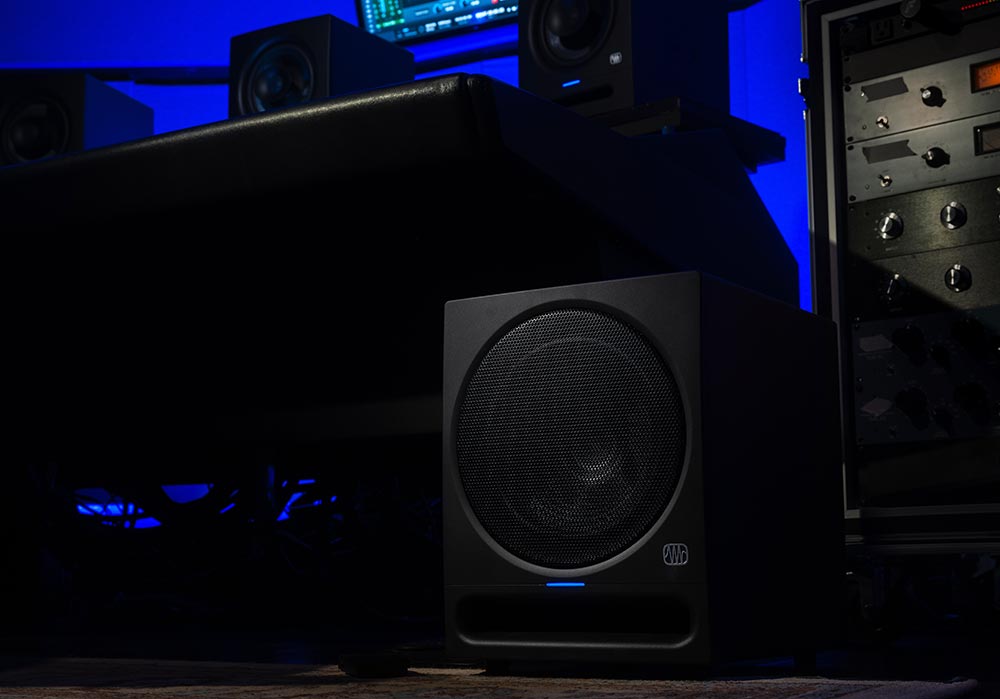
PreSonus Eris Pro 10 Sub Features:
- 10-inch, front-firing, glass-composite, low-frequency transducer
- Front-firing, bass-reflex acoustic port
- Continuously variable lowpass filter (50 Hz to 130 Hz) sets the upper frequency reproduced by the subwoofer
- Switchable highpass filter removes frequency content below 80 Hz from the full-range subwoofer outputs to the main monitors
- Momentary footswitch (included) bypasses the subwoofer, highpass filter, and Sub Out
- Input gain control (-30 dB to +6 dB, continuously variable), polarity invert switch, and ground-lift switch
- 170 watt (RMS), Class AB amplification for up to 113 dB SPL, with a frequency response of 20 to 200 Hz
- Left and right, balanced XLR and 1/4-inch TRS and unbalanced RCA main inputs
- Left and right balanced XLR and 1/4-inch TRS outputs and XLR subwoofer output for connecting a second Eris Pro Sub 10

The easiest way for electronic musicians to get their music onto Spotify, Apple Music, iTunes, Amazon Music, Tidal, Instagram, Facebook, TikTok, Pandora, Twitch & much more! Click the banner above or the Go Button to save 7% off of your signup! Go!
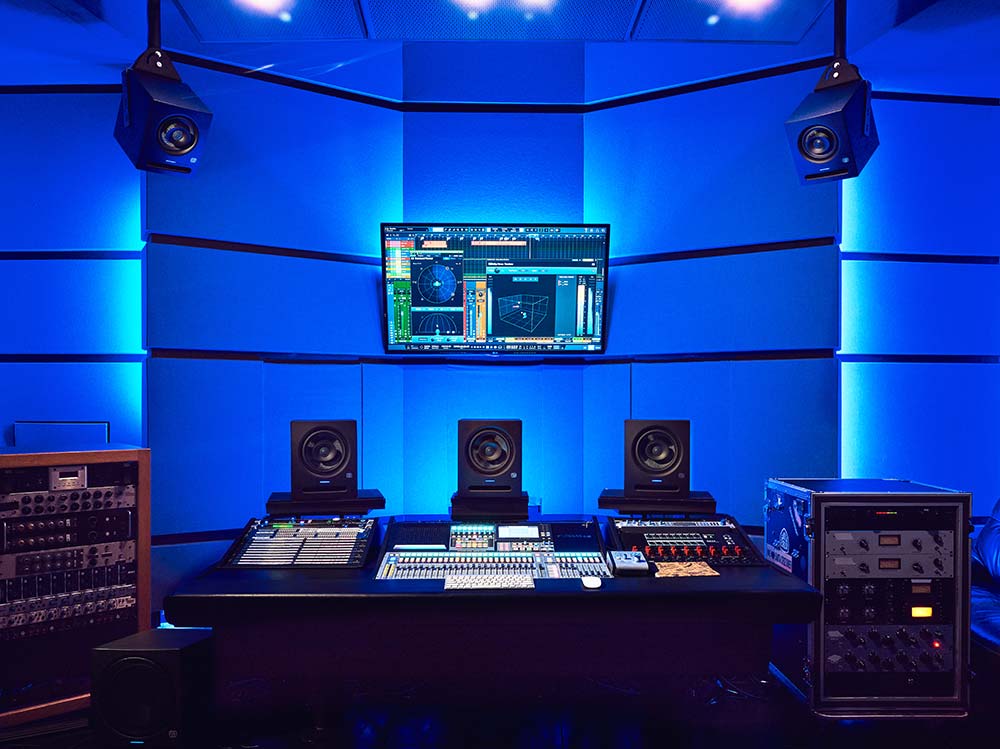
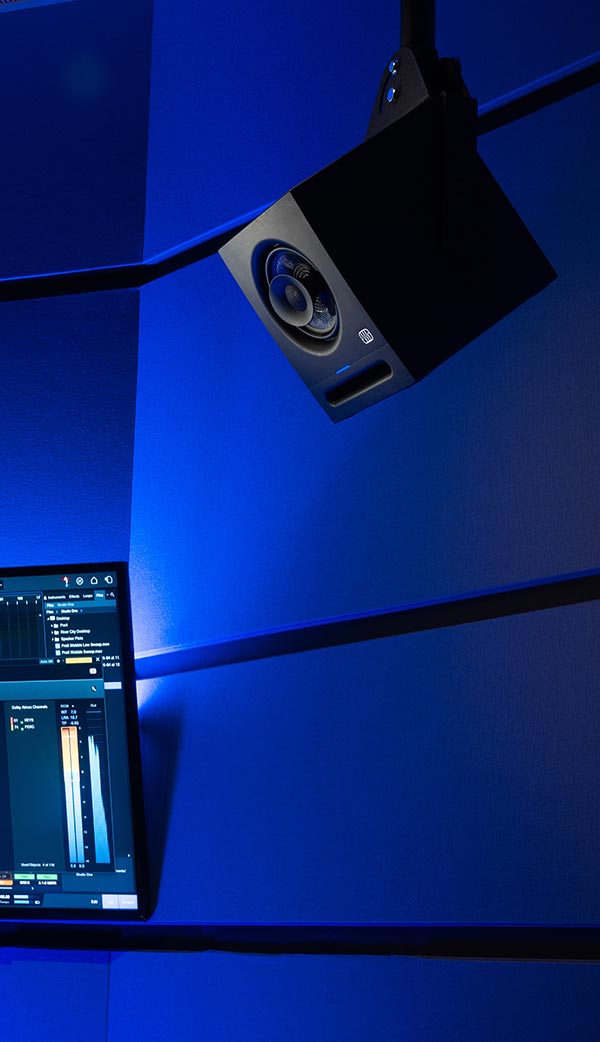
Spending considerable time with the symmetric design of the Eris Pro 8’s proved to our reviewers that the phase alignment was a “considerable asset” in nearfield monitoring, and mixing in Atmos. For “producers in confined spaces, the symmetic [design] provided a wide soundstage for accurate stereo imaging.” Another tester compared the Eris Pro 8’s to his JBL’s with a traditional design and was struck by the width. For surround sound mixing in Atmos, one reviewer found the Pro 8’s to provide “tremendous value” with a “consistent sound signature,” a “compact form factor” and the “many tuning features.” For “surround sound mixers who are on a budget, the Eris [Pro 8’s] makes your money go the distance.”
Conclusion
It can come as no surprise at this point that we’re fond of the Presonus Eris Pro 8 and the Pro 10 sub ecosystem. With everything significantly more expensive these days, it almost feels like these Presonus monitors are an anomaly. They provide incredible value, contain savvy features, and punch way above their weight in performance. No wonder they won a FutureMusic Gear Of The Year Award, and now a Power Award. Highly Recommended.
PreSonus Eris Pro Monitors Rating: 91%
Cheers:
+ Value
+ Tuning
+ Features
+ Soundstage
+ Footswitch
+ Performance
+ Easy Setup
+ Versatile
Jeers:
– Build Quality
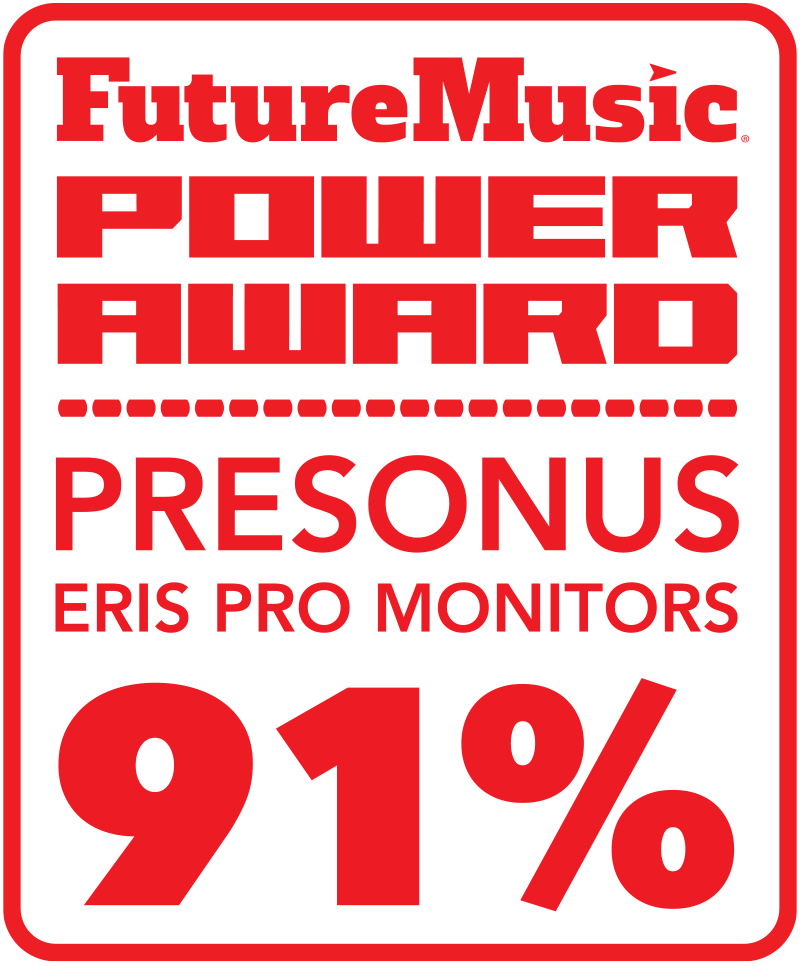
PreSonus Eris Pro 8 monitors cost $/€499.99 each. The Pro 10 Sub will set you back $/€449.99.
The Future: The vinyl covered Medium Density Fiberboard (MDF) damages too easily and needs to be adjusted to make them more robust. Additional quality control should also be considered so that the Eris series don’t leave the factory with slapdash construction aesthetics, which take away from what PreSonus was able to achieve with this series.






